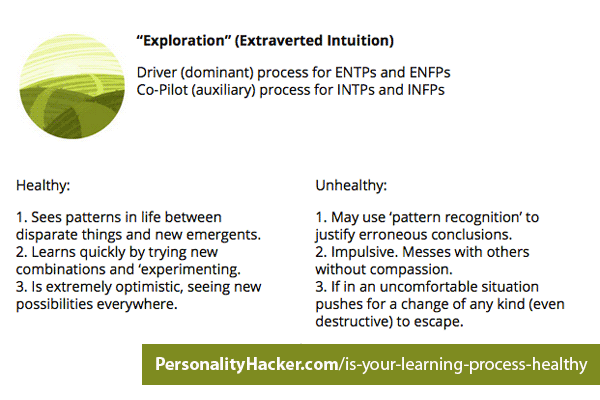The technical name for a learning mental process is your ‘perceiving’ cognitive function. For a complete list of type functions, please refer to these quick reference guides. To find a list of healthy and unhealthy expressions of the ‘judging’ cognitive functions please reference the podcast “Developed vs. Undeveloped Decisions.“
 “Perspectives” (Introverted Intuition)
“Perspectives” (Introverted Intuition)
Driver (dominant) process for INTJs and INFJs
Co-Pilot (auxiliary) process for ENTJs and ENFJs
Healthy:
1. Dives deep into the subconscious to see patterns within the human mind.
2. Is not married to own perspectives, so can usually find different perspectives, including specific ones of others.
3. Sees into the future.
Unhealthy:
1. Becomes ‘trapped’ in inner world and stream of consciousness dialog.
2. Paranoid. “Switches perspectives” to see ill intent and to justify erroneous conclusions.
3. May become fearful of the future, assuming worst case scenarios.
“Exploration” (Extraverted Intuition)
Driver (dominant) process for ENTPs and ENFPs
Co-Pilot (auxiliary) process for INTPs and INFPs
Healthy:
1. Sees patterns in life between disparate things and new emergents.
2. Learns quickly by trying new combinations and ‘experimenting.
3. Is extremely optimistic, seeing new possibilities everywhere.
Unhealthy:
1. May use ‘pattern recognition’ to justify erroneous conclusions.
2. Impulsive. Messes with others without compassion.
3. If in an uncomfortable situation pushes for a change of any kind (even destructive) to escape.
 Introverted Sensing, aka “Memory”
Introverted Sensing, aka “Memory”
Driver (dominant) process for ISTJs and ISFJs
Co-Pilot (auxiliary) process for ESTJs and ESFJs
Healthy:
1. Works like a multi-sensory autobiographer, recording and reliving personal experiences and their significance/impact.
2. Preserves precedent and order, and will create it if not present.
3. Desires/understands stability and tradition.
Unhealthy:
1. Can feel trapped by past experiences or decisions.
2. Seeks psychological comfort, retreating to ‘comfort zones’ avoiding all growth.
3. Becomes resistant to new experiences and hostile to novelty.
 Extraverted Sensing, aka “Sensation”
Extraverted Sensing, aka “Sensation”
Driver (dominant) process for ESTPs and ESFPs
Co-Pilot (auxiliary) process for ISTPs and ISFPs
Healthy:
1. Understands athletics and kinesthetics, learns through movement and activity.
2. Is fully present and in the moment.
3. Loves being in action and pushes the body and environment to their limits; naturally understands ‘body language’.
Unhealthy:
1. Becomes physically self-indulgent. Wants to feed cravings – food, sex, alcohol, drugs, exercise, etc…
2. Won’t consider future consequences or how actions impact others.
3. Can become reckless.
Here Are The Above Descriptions In Shareable Images
Want to learn more?
Discover Your Personal Genius







Share:
Chakra Exercises for Highly Sensitive People
Can Emotional Trauma Impact Personality Typing?
10 comments
I can’t quite own the meaning of “Sees patterns in life between disparate things and new emergents.” I know what disparate and emergent mean, just not sure of what is found between the two.
The most ironic thing with Extraverted Sensing is that the need to feel alive can literally kill us. We do stupid shit and then it hurts our bodies and our situations. This reduces our ability to experience things which causes us to do even more stupid shit to satisfy the sensation we are lacking. And the cycle continues. It’s such a self-defeating, self-destructive function. Wish I could start again knowing this. I would seriously have taken care of my body before it got this bad.
Thanks, Charis :)!
Thanks for your question Lance! We did a similar graph for one of the podcasts. Here is a link to that podcast: http://www.personalityhacker.com/podcast-episode-0068-developed-vs-undeveloped-decisions/
This format is very helpful as I learn the site’s language. Is there a page with the identical format (Healthy/Unhealthy lists) for the Judging functions?
You explain the Judging information on several pages, but this particular format is really easy to grasp.
Thanks.